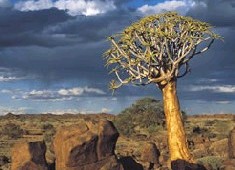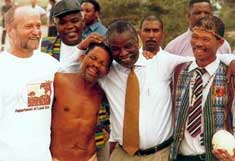SA's eighth World Heritage Site
Bongani Mlangeni
29 June 2007
The Richtersveld Cultural and Botanical Landscape has become the eighth South African site to be inscribed on the World Heritage List of the UN Educational, Scientific and Cultural Organisation (Unesco) as a place of "outstanding value to humanity". The site was listed during the 31st session of Unesco's World Heritage Committee in New Zealand on Wednesday.
World Heritage in South Africa
Did you know that the Vredefort Dome is the largest and oldest visible meteor impact crater in the world? Or that the Drakensberg has Africa's richest concentration of rock art? SA is home to eight Unesco World Heritage sites, places of "outstanding value to humanity". 
|
|
Already listed are SA's Cape Floral Region, Cradle of Humankind, Isimangaliso Wetlands Park (formerly the Greater St Lucia Wetlands Park), Mapungubwe Cultural Landscape, uKhahlamba-Drakensberg Park, Robben Island and Vredefort Dome.
The Richtersveld Cultural and Botanical Landscape covers 160 000 hectares of dramatic mountainous desert in the north-west part of South Africa. A unique feature of the site - both in South African and international terms - is that it is owned and managed by a community that until recently had very little to call its own.
Characterised by extreme temperatures, the communally run landscape affords a semi-nomadic pastoral livelihood for the Nama people, descendants of the Khoi-Khoi people who once occupied lands across southern Namibia and most of the present-day Western and Northern Cape provinces of
South Africa.
A century or more back, the Khoi-Khoi were pushed north by the spread of farms from the Cape. A few years ago, the Richtersveld area was returned to the ownership of the Nama under South Africa's land restitution programme.
Today the Nama live in three small villages, established as mission settlements outside the proclaimed area: Kuboes to the north, Lekkersing to the south-west, and Eksteenfontein to the south. The seasonal migration of the Nama between stock-posts with traditional demountable mat-roofed houses reflect a practice, once widespread over southern Africa, which has persisted for at least two millennia - the Nama being its last practitioners.
"The extensive communal grazed lands bear testimony to the land management processes which have ensured the protection of the succulent Karoo vegetation," the World Heritage Committee said in a statement. "This demonstrates a harmonious interaction between people and nature."
Source: BuaNews
 Quiver Tree. The Richtersveld is situated in one of the most species-rich arid zones in the world (Photo copyright Walter Knirr / South African Tourism)
Quiver Tree. The Richtersveld is situated in one of the most species-rich arid zones in the world (Photo copyright Walter Knirr / South African Tourism)
 Then Deputy President Thabo Mbeki embraces Khomani San leaders Dawid Kruiper (left) and Petrus Vaalbooi (right) at the 1999 celebration of South Africa's first successful aboriginal land claim. On the left is former Land Affairs Minister Derek Hanekom (Photo: South African San Institute)
Then Deputy President Thabo Mbeki embraces Khomani San leaders Dawid Kruiper (left) and Petrus Vaalbooi (right) at the 1999 celebration of South Africa's first successful aboriginal land claim. On the left is former Land Affairs Minister Derek Hanekom (Photo: South African San Institute)





